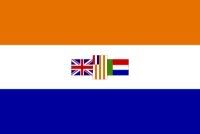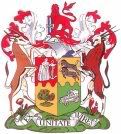South Africa
From Kaiserreich
| ||||||
| Motto Ex Unitate Vires | ||||||
| Official Language | English, Afrikaans | |||||
| Capital | Pretoria | |||||
| Head of State | Jan Smuts | |||||
| Head of Government | Jan Hendrik Hofmeyr | |||||
| Establishment - South Africa Act 1909 | May 31 1910 | |||||
| Government | Semi-presidential republic | |||||
| Currency | South African pound | |||||
| Area | Around 1.850.000 km² | |||||
| Population | Around 10 million | |||||
South Africa is a country in Africa. It is bordered by Mittelafrika to the north-west and the Portuguese colony of Mozambique to the north-east.
Contents |
History
The interior of South Africa remained largely unsettled by whites well into the 19th century. This changed upon the discovery of vast diamond and gold deposits in the area. The influx of British prospectors soon led to increasingly violent confrontations between British colonials and Boer Republicans. The period also saw the final, violent repressions of the last remaining free chiefdoms in South Africa. An attempt at a federal system incorporating both the colonies and the Boer republics was shattered by a Boer victory over the British at Majuba in 1881. The resulting Anglo-Boer War, which raged from 1899-1902, led to an annexation of the Boer republics. The Boers, however, won the peace, creating a constitution that ensured the retention of white-only rule in South Africa. White Afrikaners still, however, held a great deal of resentment towards the British Empire. Following the events of the 1925 British Revolution South Africa was able to annex the former British Bechuanaland Protectorate and South Rhodesia, but had to leave the other african regions of the British Empire in German hands (later included in Mittelafrika). In 1924 the rising discontent with the government led to his defeat by a coalition of the pro-Afrikaner National Party and the socialist South African Labour Party. James Hertzog, the leader of the National Party and once a Boer general, became the new President of South Africa. Hertzog encouraged the development of the Afrikaner culture and was determined to protect the Afrikaner from British influence. This led to increasing tension between South Africa and the British Empire which culminated in South Africa leaving the Entente in February 1925, a decision that has been heavily contested after much of the neighbouring regions fell in German hands after the British Revolution. In the 1933 election the newly created United Party won a non-absolute majority and formed a minority government led once again by Jan Smuts. The United party worked for a reconciliation with the Royal Family and the Entente, but the opposition of the National Party prevented any actual action in that direction.
Politics
In the 1933 South African general election the United Party led by Jan Smuts received more votes than the National Party led by James Hertzog and the Labour Party led by William Andrews, but did not achieve an absolute majority and was therefore forced to form a minority government. New elections are scheduled for May 1938 and as of now it is impossible to predict who the people will chose.
Head of State: Jan Smuts
Head of Government: Jan Hendrik Hofmeyr
Foreign Minister: Jan Smuts
Minister of Armament: Jan Hendrik Hofmeyr
Minister of Security: Nicolaas Jacobus de Wet
Minister of Intelligence: Jan Smuts
Chief of Staff: Pierre van Ryneveld
Chief of Army: James Mitchell-Baker
Chief of Navy: Pierre Oliver-Knoll
Chief of Air Force: Pierre van Ryneveld
Military
Army
South Africa has a small army, for defence purposes, consisting in 3 division located in Cape Town, Johannesburg and Durban (the latter two only at half strenght). However, there are rumours about a possible expansion of the army in the future, as part of the military would like to take the initiative and expand the borders of South Africa at the expenses of its neighbours.
Navy and Air Force
When the British fleet was recalled to Canada in 1930, the coasts of South Africa were left undefended. Since then, only one light cruiser has been purchased and a handful of destroyers were built, but the military and the government had to face the fact that they did not have the funds to have a serious naval program to protect the country from external threats. There is no air-force and there are no serious plans for creating one.
Foreign Relations
Very good relations and with Canada and Australasian Confederation. Both countries also grant military access to South Africa.
Friendly relations with Portugal and Mittelafrika.
Unfriendly relations with Abyssinia.
Culture
The victory of the pro-Afrikaner National Party in the 1924 elections was very important for the development of the Afrikaner culture. Afrikaans replaced Dutch as the second official language of South Africa (with English) on 5 May 1925. Since then, the Afrikaner language and culture gained more and more importance.


